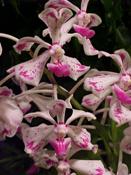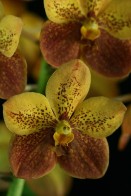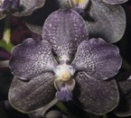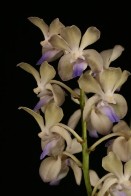Vanda Culture
Light
 The vanda type orchids can take almost full morning sun but need shade during the hottest part of the day and during most of the day in summer. Under greenhouse conditions with high humidity, maximum sunlight should be given with only enough shade to keep the temperature within the appropriate range. Light conditions for these plants are the highest you can give them without sun-burning the leaves. You can hang the plant in the Lanai or pool cage, or try it hanging under a citrus or similar tree. Oak trees can be too shady if they are very dense, large trees. Inside the home is not recommended, however, growers will have to compromise by keeping the plants in the sunniest site possible in the home (Southern exposure is the best) for the winter and then move the plants outside to a lightly shaded spot. Vandas can tolerate full sun only if they are moved out into this situation gradually. Baby steps just like you would condition your own skin for a full day out in the sun. They can tolerate full morning sun if the conditions in the home are bright and sunny and then you can increase the dosage a little each week. You want to keep your plant growing.
The vanda type orchids can take almost full morning sun but need shade during the hottest part of the day and during most of the day in summer. Under greenhouse conditions with high humidity, maximum sunlight should be given with only enough shade to keep the temperature within the appropriate range. Light conditions for these plants are the highest you can give them without sun-burning the leaves. You can hang the plant in the Lanai or pool cage, or try it hanging under a citrus or similar tree. Oak trees can be too shady if they are very dense, large trees. Inside the home is not recommended, however, growers will have to compromise by keeping the plants in the sunniest site possible in the home (Southern exposure is the best) for the winter and then move the plants outside to a lightly shaded spot. Vandas can tolerate full sun only if they are moved out into this situation gradually. Baby steps just like you would condition your own skin for a full day out in the sun. They can tolerate full morning sun if the conditions in the home are bright and sunny and then you can increase the dosage a little each week. You want to keep your plant growing.
Humidity and Ventilation
 Vandaceous orchids appreciate high humidity and gentle breezes if you can provide it for them. On hot, sunny days, at least 60% humidity is appropriate. Usually the summer rains and winds are enough if you protect them against too much wind. Hanging the plants near running water, ponds creeks or the pool can increase humidity as will putting the orchid above where other plants are growing. Soaking the ground below the vandas also creates a humid environment by evaporation. Salt water from ocean breezes can be harmful.
Vandaceous orchids appreciate high humidity and gentle breezes if you can provide it for them. On hot, sunny days, at least 60% humidity is appropriate. Usually the summer rains and winds are enough if you protect them against too much wind. Hanging the plants near running water, ponds creeks or the pool can increase humidity as will putting the orchid above where other plants are growing. Soaking the ground below the vandas also creates a humid environment by evaporation. Salt water from ocean breezes can be harmful.
Watering and Feeding
 High daytime humidity is essential, especially on sunny days. Vandaceous plants outdoors may need watering and misting several times daily during the growing season when the sun is bright. During the rainy season here in Florida, the plants do not usually need extra watering, but do feed them. Indoors, somewhat less watering is required, but heavy misting once or twice a day in bright weather will be helpful. Water less in winter, during long cloudy spells, or after repotting.
High daytime humidity is essential, especially on sunny days. Vandaceous plants outdoors may need watering and misting several times daily during the growing season when the sun is bright. During the rainy season here in Florida, the plants do not usually need extra watering, but do feed them. Indoors, somewhat less watering is required, but heavy misting once or twice a day in bright weather will be helpful. Water less in winter, during long cloudy spells, or after repotting.
Vandaceous orchids are heavy feeders when growing. Plants in greenhouses should be given a solution of well balanced fertilizer (20-20-20) once a week during the growing season. Outdoor plants require a heavier concentration of the same fertilizer. During the non-growing season (Nov-Jan), apply the same proportions every two to four weeks rather than weekly. In addition at every third feeding substitute a bloom booster fertilizer. This is a feeding program for all year long. Vandas do not like their roots disturbed. Some people use nothing in the pot or basket. Others use some large bark or horticultural charcoal in baskets to hold them in an upright position while the roots are growing and attaching to the basket. You can also use wire ties to secure the plant in an upright position or no medium at all. The roots will eventually attach to the baskets and be very happy about the freedom.
During the hot summer months you will want to water your vandaceous plant every day. When temperatures outside exceed 90F, you may have to water even it more. The secret to growing these plants vigorously is the high light and good watering/feeding they receive. They are heavy feeders. Inside watering and fertilizing can be easily accomplished by running this sink sprayer on the plants roots and then having a spray bottle with fertilizer mix handy and then giving the roots a spray with this mixture. I would fertilize them every other watering in the home. Your fertilizer mixture would be ½ strength of the manufacturers recommended application. Outside I recommend you use a hose end sprayer to apply the water first and then the water fertilizer mixture. During the summer, I fertilize every watering. Make sure this hose end sprayer has never been used for applying herbicides in the past. Water them early in the day so the water temperature is not too shocking for them. Never water with very cold or very hot water. As the day goes on the water inside the hose can become very warm. If the water temperature coming out of the hose is comfortable for you, then it will be fine for watering orchids. Remember that watering with cold or hot water in comparison to leaf temperatures can shock your plant or cause leaf damage. Don’t forget to give good water during the cooler winter months.
Fertilizer
 Fertilizer helps your plants. It is good to fertilizer every 2-3 weeks (quarter to half teaspoon per gallon of water.) The more filtered sun the plant gets the more fertilizer it can use. Any balanced household plant food will work fine. You can use 10-10-10, 15-30-15 or 20-20-20 similar fertilizer. No fertilizer is used from November through mid February. Too much nitrogen fertilizer after late Summer keeps some Dens from blooming. Just use it!
Fertilizer helps your plants. It is good to fertilizer every 2-3 weeks (quarter to half teaspoon per gallon of water.) The more filtered sun the plant gets the more fertilizer it can use. Any balanced household plant food will work fine. You can use 10-10-10, 15-30-15 or 20-20-20 similar fertilizer. No fertilizer is used from November through mid February. Too much nitrogen fertilizer after late Summer keeps some Dens from blooming. Just use it!
Temperature
 Vandaceous orchids grow best under warm daytime conditions of 65F or higher but can withstand long spells of hot weather and short spells of cold. They will continue in active growth anytime of the year if given warm temperatures and bright light. Night temperatures generally should be 60F or higher but not usually lower than 50F. Temps into the 40’s can be risked but only for short periods of time. Bring them in if in doubt.
Vandaceous orchids grow best under warm daytime conditions of 65F or higher but can withstand long spells of hot weather and short spells of cold. They will continue in active growth anytime of the year if given warm temperatures and bright light. Night temperatures generally should be 60F or higher but not usually lower than 50F. Temps into the 40’s can be risked but only for short periods of time. Bring them in if in doubt.